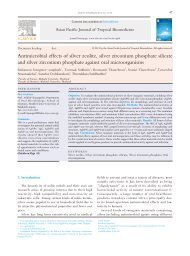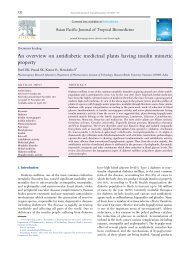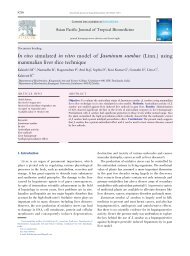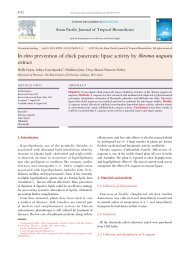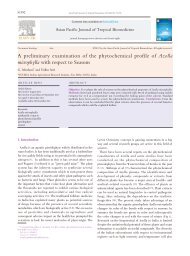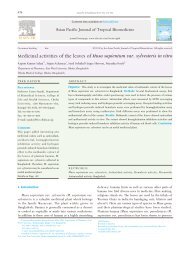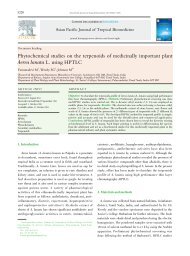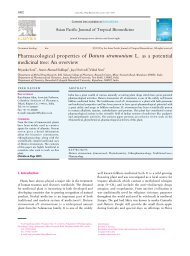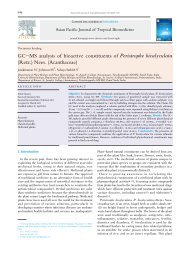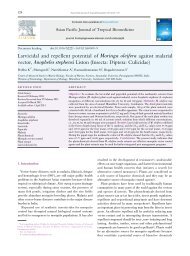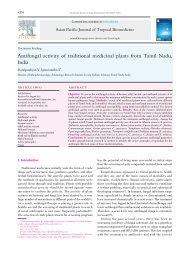Preliminary phytochemical studies on the methanolic ... - Apjtb.com
Preliminary phytochemical studies on the methanolic ... - Apjtb.com
Preliminary phytochemical studies on the methanolic ... - Apjtb.com
Create successful ePaper yourself
Turn your PDF publications into a flip-book with our unique Google optimized e-Paper software.
S80<br />
Johns<strong>on</strong> Marimuthu @ Ant<strong>on</strong>isamy et al ./Asian Pacific Journal of Tropical Biomedicine (2012)S79-S82<br />
while <strong>the</strong> leaves are against kidney diseases, urethra<br />
inflammati<strong>on</strong>s and as an antidote against animal pois<strong>on</strong>s.<br />
Several <str<strong>on</strong>g>phytochemical</str<strong>on</strong>g> <str<strong>on</strong>g>studies</str<strong>on</strong>g> were performed with different<br />
parts of S. campanulata, including stem barks, leaves,<br />
flowers and fruits. The leaves have furnished spathodol,<br />
caffeic acid and o<strong>the</strong>r phenolic acids and flav<strong>on</strong>oids,<br />
while fruits c<strong>on</strong>tain polyphenols, tannins, sap<strong>on</strong>ins and<br />
glycosides. The plant leaf is used in <strong>the</strong> treatment of painful<br />
inflammati<strong>on</strong>, c<strong>on</strong>stipati<strong>on</strong>, dysentery, and is reported<br />
to have anti-plasmodial activity, analgesic and antiinflammatory<br />
acti<strong>on</strong>s, anti-larvicidal activity and repellent<br />
activity, anti-c<strong>on</strong>vulsant effect and antimicrobial activity[15-<br />
23]. In Thailand, flour coated leaves and flowers of Antig<strong>on</strong><strong>on</strong><br />
leptopus (A. leptopus) Hook. Et. Arn. are served with noodles.<br />
The flowers are also used in omelets[24]. Traditi<strong>on</strong>ally <strong>the</strong><br />
leaves of A. leptopus have been used to reduce swelling,<br />
and a tea from <strong>the</strong> leaves can be made to treat diabetes and<br />
<strong>the</strong> blossoms is used to treat high blood pressure. A hot tea<br />
prepared from <strong>the</strong> aerial porti<strong>on</strong> of this plant is used as a<br />
treatment for cough and throat c<strong>on</strong>stricti<strong>on</strong> in Jamaica and<br />
c<strong>on</strong>sidered as <strong>on</strong>e of <strong>the</strong> important medicinal plants in <strong>the</strong>ir<br />
folk medicine. The vine is used to treat cough and throat<br />
c<strong>on</strong>stricti<strong>on</strong>. It possesses anti-cogualnt activity, analgesic,<br />
anti-thrombin, anti-inflammatory activity, anti-diabetic<br />
and lipid peroxidati<strong>on</strong> inhibitory activities, anti-<strong>the</strong>lmentic<br />
activity and anti-c<strong>on</strong>vulsant activity[25-27]. But <strong>the</strong>re is no<br />
report about <strong>the</strong> <str<strong>on</strong>g>phytochemical</str<strong>on</strong>g> c<strong>on</strong>stituents study <strong>on</strong> <strong>the</strong><br />
<strong>methanolic</strong> flower extracts of H. isora, S. campanulata, A.<br />
leptopus and Thunbergia grandiflora (T. grandiflora) from<br />
India. With this background <strong>the</strong> present study was aimed to<br />
explore <strong>the</strong> <str<strong>on</strong>g>phytochemical</str<strong>on</strong>g> c<strong>on</strong>stituents of <strong>the</strong> <strong>methanolic</strong><br />
flower extracts of H. isora, S. campanulata, A. leptopus and<br />
T. grandiflora.<br />
2. Materials and methods<br />
The flowers of H. isora L. (Sterculiaceae), S. campanulata<br />
P. Beavu (Bign<strong>on</strong>iaceae), A. leptopus L.(Polyg<strong>on</strong>aceae)<br />
and T. grandiflora Roxb. (Acanthaceae) were collected<br />
from Kanyakumari Wildlife Sanctuary, Tamil Nadu, India<br />
and au<strong>the</strong>nticated by Dr. S. Jeeva, following identificati<strong>on</strong><br />
a voucher specimen of <strong>the</strong> plant was deposited in <strong>the</strong><br />
herbarium of Department of Botany, Nesam<strong>on</strong>y Memorial<br />
Christian College, Marthandam-629165, Tamil Nadu, India.<br />
The flowers were examined carefully and old, infected,<br />
and fungus damaged flowers were removed. Extracts were<br />
prepared from fresh flowers. 50 g of fresh flowers petals of<br />
H. isora, S. campanulata, A. leptopus and T. grandiflora<br />
were collected and kept in closed c<strong>on</strong>ical flask with 200 mL<br />
of methanol in a shaker at room temperature for 24 h. After<br />
incubati<strong>on</strong>, <strong>the</strong> extracts were filtered through Whatman No.<br />
41 filter paper and <strong>the</strong> extracts were collected and stored in<br />
<strong>the</strong> refrigerator at 4曟. The <strong>methanolic</strong> flower extracts were<br />
c<strong>on</strong>centrated using vacuum evaporator and dried at 60曟.<br />
The preliminary <str<strong>on</strong>g>phytochemical</str<strong>on</strong>g> screening was performed by<br />
Harborne method[28].<br />
3. Results<br />
The crude <strong>methanolic</strong> flower extracts of H. isora, S.<br />
campanulata, A. leptopus and T. grandiflora c<strong>on</strong>tained a<br />
greater proporti<strong>on</strong> by mass of <strong>the</strong> <strong>com</strong>p<strong>on</strong>ent <strong>com</strong>pounds as<br />
shown in Table 1. The results of <strong>the</strong> <str<strong>on</strong>g>phytochemical</str<strong>on</strong>g> screening<br />
revealed that alkaloids, phenol, tannins, xanthoproteins,<br />
carboxylic acid, coumarins and carbohydrates presence in<br />
<strong>the</strong> <strong>methanolic</strong> extracts of H. isora. The <strong>methanolic</strong> extracts<br />
of S. campanulata displayed <strong>the</strong> presence of alkaloids,<br />
phenol, coumarins and carbohydrates. The phenol, sap<strong>on</strong>ins,<br />
aminoacids, steroids, phytosterols, triterpenoids, sapogenis,<br />
tannins, xanthoprotein, carboxylic acid and coumarins<br />
were present in <strong>the</strong> <strong>methanolic</strong> extracts of A. leptopus.<br />
The <strong>methanolic</strong> extracts of T. grandiflora showed <strong>on</strong>ly <strong>the</strong><br />
alkaloids and phenols presence and o<strong>the</strong>r c<strong>on</strong>stituents<br />
were failed to dem<strong>on</strong>strate in <strong>the</strong> <strong>methanolic</strong> extracts of T.<br />
grandiflora.<br />
Table 1.<br />
Phytochemical screening of <strong>the</strong> <strong>methanolic</strong> extracts of H. isora L., S. campanulata P. Beavu, A. leptopus L and T. grandiflora Roxb flowers.<br />
Phytochemical c<strong>on</strong>stituents<br />
H. isora<br />
Botanical name<br />
S. campanulata A. leptopus T. grandiflora<br />
Alkaloids + + - +<br />
Phenol + + + +<br />
Flavanoids - - - -<br />
Sap<strong>on</strong>ins - - + -<br />
Aminoacids - - + -<br />
Quin<strong>on</strong>es - - - -<br />
Steroids, phytosterols,<br />
triterpenoidal sapogenis<br />
- - + -<br />
Tannins + - + -<br />
Xanthoproteins + - + -<br />
Carboxylic acid + - + -<br />
Coumarins + + + -<br />
Carbohydrates + + - -



